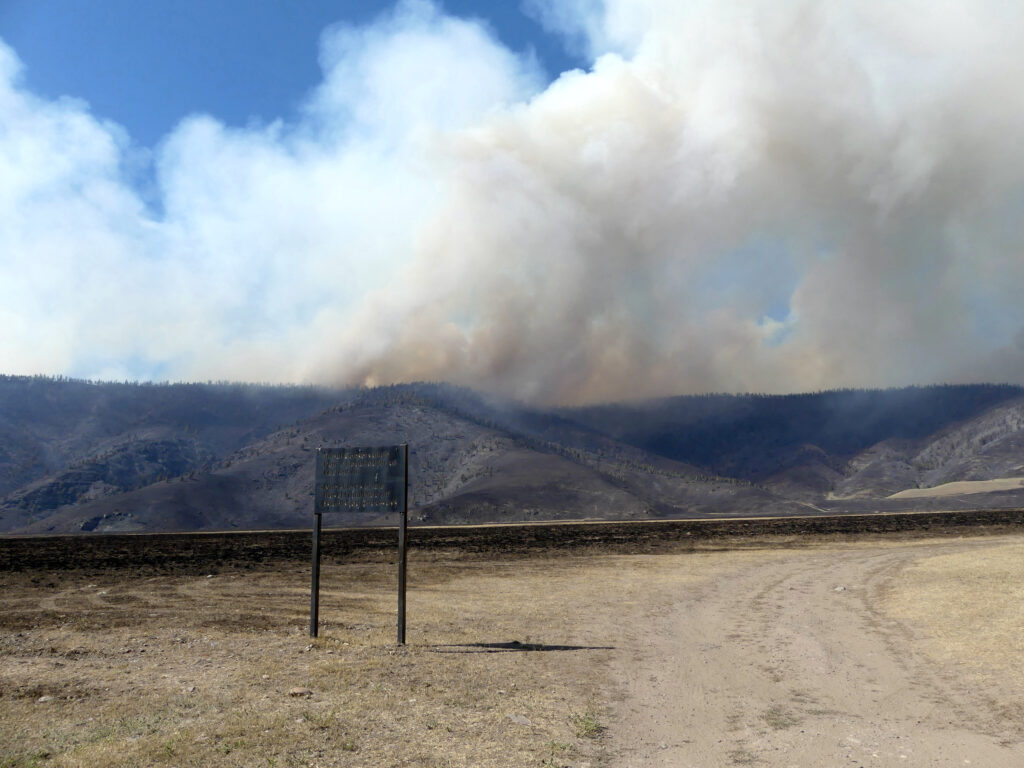The Elmo fire near Kalispell, Montana on July 30, 2022 (Photo by Les Zaitz for the Daily Montanan).
Montanans should expect to see more smoke this summer and early fall than last year, but officials say it’s predicted to remain a normal fire season for the state, albeit with likely at least 25% more activity than 2023.
The recent late spring moisture is expected to delay the start of fire season into later in July and that season will likely continue into September, forecasters told Gov. Greg Gianforte on Tuesday at a fire season outlook briefing.
The vast majority of fires are started by humans, with this year being no exception, and Gianforte said nearly all of the 400 fires this year so far have been caused by humans.
Officials said Montana may see smoke from other parts of the country, particularly from drier California and from the recent fires in New Mexico. But officials said it wouldn’t compare to the Canadian smoke from last summer. Canada also isn’t seeing a lot of fire activity at the moment.
Predictive Services Meteorologist for the Northern Rockies Coordination Center Daniel Borsum said that even a normal fire season can result in devastating destruction of property, harkening back to 2016 when the season didn’t get started until late July but a fire in Hamilton took out several structures, including more than a dozen homes.
Borsum said the El Niño weather pattern led to below average snowpack levels this year, which had some firefighters calling him worried about the upcoming season, but Borsum said the recent moisture helped push back the season for a few weeks.
However, some places in western Montana are still missing four to eight inches of moisture from the last two years, which affects water tables and groundwater. However, as of June 1 the precipitation in western Montana is within 71-90% normal, according to the Natural Resources Conservation Service. Borsum said northwest Montana has the highest potential for fires this year, which is currently experiencing the most drought in the state, and July to September are expected to be drier.
In the last 10 years a median of 2,687 fires have burned about 179,000 acres, Borsum said. Last year, 2,400 fires burned 138,000 acres, which Borsum said was low, and why this season will seem more active in comparison. He said even if last year’s numbers were to double, the state would still be in a normal fire season – but he said to expect about a 25% increase in fire activity from last season.
Gianforte said with the passage of House Bill 883 the state doubled its fire suppression fund, appropriating $45 million for forest fire mitigation, fire preparedness, and support of local fire forces, with the Forestry Division predicting it will cost more than $42 million. The total fund is expected to have more than $106 million by the end of the fiscal year.
Fire Protection Bureau Chief for the Montana Department of Natural Resources and Conservation Matt Hall said more than 5,000 acres have burned already this season, and with that being less than normal, crews have had the opportunity to train ahead of the season.
Fire prevention tips include
Staying current on weather conditions and fire restrictions in your area.
Always using an established ring fire and never leaving campfires unattended.
Ensuring trailer chains are properly secured and not dragging on the pavement.
Properly maintaining and cleaning farm and lawn equipment.
Avoiding driving or parking your vehicle, including all-terrain and utility vehicles, on dry grass.
Using caution when burning debris and never burning piles when it’s hot, windy, or when fire restrictions are in place.
For current fire information and additional tips on preventing human-caused wildfire, visit https://www.mtfireinfo.org/.
The post Fire outlook worse than 2023, but still considered normal appeared first on Daily Montanan.

